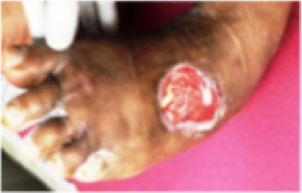Reducing Shear Pressure To Facilitate Healing Of A Dorsal Foot Wound
These authors address the impact of shear forces in the treatment of a dorsal ulcer initially caused by a toe ring worn by a 61-year-old patient.
 A 61-year-old female with type 2 diabetes (duration 11 years) presented with an ulcer on the dorsum of the left foot. The patient had hypertension for 15 years, dyslipidemia and diabetic peripheral neuropathy. She had normal peripheral circulation, diabetes and stage 4 chronic kidney disease.
A 61-year-old female with type 2 diabetes (duration 11 years) presented with an ulcer on the dorsum of the left foot. The patient had hypertension for 15 years, dyslipidemia and diabetic peripheral neuropathy. She had normal peripheral circulation, diabetes and stage 4 chronic kidney disease.
The patient said the ulcer started out as a scratch from a toe ring on the right foot. Soon the scratch became an ulcer and spread in size to the point where it measured 52 x 45 mm when she attended our clinic. After ensuring good metabolic control pertaining to glycemia and lipids, we observed universal principles of wound management and applied a proper dressing. There was no evidence of local infection with negative culture and sensitivity tests. Accordingly, we provided conservative management along with periodic debridement.
Despite good wound care, the dorsal wound showed no evidence of healing for one month. Being a busy housewife, the patient had little time for rest in bed. Routinely, we would have not insisted much on rest since the wound was on the dorsal surface.
However, finding no obvious factor responsible for the lack of healing, we hypothesized that even shear forces working in the region of the dorsal foot due to the patient’s frequent steps inside the house, may impair wound healing since newer studies have a found major role of shear pressure in the generation and non-healing of plantar foot wounds.1
What You Should Know About The Samadhan System For Offloading
With a goal of reducing shear pressure, we asked the patient to use the Samadhan System, an offloading device which we expected to reduce shear pressure along with plantar pressure.2 The Samadhan System has three components: a “Samadhan Unit” (a foam cylinder), a retainer (a piece of elastocrepe bandage and fasteners (metallic hooks provided with the Elastocreppe bandage) to fix the edges of the elastocrepe bandage.
The Samadhan Sytem, being softer in consistency, reduces local plantar pressure (vertical pressure), which is accompanied by reduced sheer pressure (horizontal pressure), being perpendicular to the plane of plantar pressure. Hence offloading shall also reduce pressure on the wound on dorsal surface of the foot. One places the Samadhan Unit over the midfoot region.2
The results were visible within 15 days as the size of the wound started reducing and healed completely in next two months.
Current Insights On The Effects Of Shear Pressure
There are two key forces that act upon the foot during walking. There is a vertical component perpendicular to the skin surface (vertical pressure/plantar pressure) and a horizontal component parallel to the skin surface (shear stress/pressure).3 Peak plantar pressure is less important than peak shear pressure. In one study, peak plantar pressure predicted the location in only 38 percent of patients.4 Shear pressure is virtually the frictional effect on skin and the force should increase when patients walk, even if the wound is on the dorsal surface.
With this idea in mind, we recommend routine offloading in dorsal foot ulcers, especially if they are non healing in nature. This case report intends to emphasize that rest and reduction of shear pressure is important even for dorsal foot ulcers.
Due to the lack of commercial devices that can measure shear forces, little work has been done to assess their role in the non-healing of foot wounds, especially those located on the dorsal surface.1 More studies would be beneficial for further exploration of the impact of shear forces on wounds in high-risk patients.
Dr. Lakshmi K. Shankhdhar is an Endocrinologist and the Medical Director of the LK Diabetes Centre in Lucknow, the only exclusive diabetes clinic in North India. He is the fourth Indian to receive the Wockhardt Medical Excellence Award and Visiting Fellowship of Harvard Medical International, the international arm of Harvard Medical School. Dr. Shankhadar has presented several abstracts and lectures at many international conferences on diabetes in addition to chairing some international conferences. He is the Principal of the Lekhraj Diabetes Hospital and Medical College in Lucknow, India.
Dr. Kshitij Shankhdhar is a diabetologist. He established the first diabetic foot clinic of North India with the Lucknow Diabetic Foot Care Clinic and Research Centre in Lucknow, India. Dr. Shankhdar has lectured at a variety of international conferences including the annual American Diabetes Association conference, the Diabetic Foot Global Conference (DFCon) and the international Malvern Diabetic Foot Conference.
Dr. Uma Shankhdhar is medical nutrition therapist at LK Diabetes Centre in Lucknow, India.
Dr. Smita Shankhdhar is a diabetes educator at LK Diabetes Centre in Lucknow, India.
References
1. Yavuz M, Botek G, Davis BL. Plantar shear stress distributions: Comparing actual and predicted frictional forces at the foot-ground interface. J Biomech. 2007; 40(13): 3045–3049.
2. Shankhdhar LK, Shankhdhar K, Shankhdhar U, Shankhdhar S. Offloading a diabetic foot ulcer in the developing world. Podiatry Today. 2015; 28(10):18-24.
3. Veves A, Murray HJ, Young MJ, Boulton AJ. The risk of foot ulceration in diabetic patients with high foot pressure: a prospective study. Diabetologia. 1992;35(7):660-663.
4. Pham H, Armstrong DG, Harvey C, Harkless LB, Giurini JM, Veves A. Screening techniques to identify people at high risk for diabetic foot ulceration: a prospective multicenter trial. Diabetes Care. 2000; 23(5):606-611.











